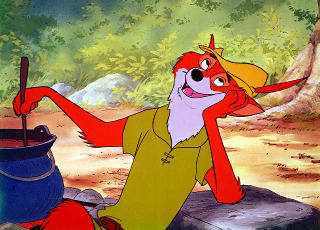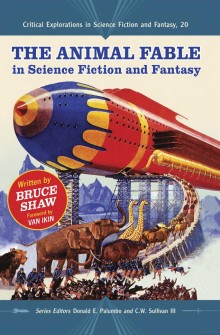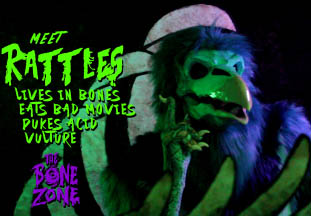criticism
Bad Kitties (or, Not Everybody Wants To Be A Cat)
Posted by StratoKasta on Mon 23 Sep 2024 - 18:45It always pleases me to say, particularly to furry audiences, that a hiatus was taken for less exciting and dramatic reasons than those they may have cooked up. In this case, I’m glad to return to posting an occasional media review here and there after five years of being between smartphones, plus the additional snag of quite the dry spell in terms of worthy things to write of. (Thanks for holding back on Jackbox, guys.)
Making use of snazzy resources, both analog and digital – remember your local libraries, folks – takes you a long way. It certainly brought these two disparate cat stories back to my attention.
Culturally F'd enters The Bone Zone
Posted by Arrkay on Mon 4 Oct 2021 - 00:54Our new Vulturally F'd host Rattles has a unique appetite. He eats terrible movies, looking for that juicy, so-bad-it's-good fermentation of cheesy old cinema. The lair he calls home is the Bone Zone, a hollowed-out corpse of a once mighty beast, nesting in an old video rental store.
With nothing but an old TV to keep him company, he shares his favourite meals with you, and warns you to steer clear of certain buffet items strewn about the floor of his cave. In proper Culturally F'd fashion, all the films Rattles will be reviewing feature anthropomorphic characters at their core. (Show trailer)
Furries of color take the mask off in times of American unrest over systemic racial biases
Posted by Sonious on Sat 6 Jun 2020 - 12:45Furries of past connected mostly via the internet behind avatars and characters of varying species. In chat rooms they would engage in discussion and role play. However, many folks of color found opportunity through being through a world where interaction was through text and art alone. That if they did not discuss or indicate their race then they could see the world in a whole new way. They could finally escape their skin and put on a new one here.
However, no one can live on the internet alone. A systemically racial bias in justice systems throughout America came to a head, once again, in the death of George Floyd, a black citizen of Minneapolis. The cruelty of this death was of grueling note as video was released of Officer Chauvin knelled down on his neck for many minutes until Mr. Floyd stopped breathing.
Why 2 Gryphon is not a comedian; according to 2 Gryphon
Posted by Sonious on Sun 26 Apr 2020 - 20:35If you were to Google the definition of a comedian you would see it defined by Dictionary.com as an entertainer whose act is designed to make an audience laugh. Likewise the New York Times has a comedy critic, Jason Zinoman, who defines comedy in a moment of reflecting on his own career of analyzing them.
This often dictates the form of my column, since while the goal of comedy is to make you laugh, what’s fascinating about the art form — especially these days, when it’s so fragmented and aesthetically diverse — is that there are many ways artists accomplish that goal.
However, if you were to ask one furry who considers himself one, 2 Gryphon, you’d find an entirely different etymology of the word, and what the job of a comic is.
It's the JOB of the comic to bring forth uncomfortable things and question them in a way that makes people think about them.Since that has become "wrong", expect that the Western world will not be laughing as much. https://t.co/EIExUX5W2h— 2, The Ranting Gryphon (@2_gryphon) June 9, 2019
It is this quote that we are going to be over-analysing today. I have broken this down into three main points as to why this definition of the job of a comedian is not only a fundamental misunderstanding of the role, but also a resignation of the foundational principles of comedy.
Was the 1973 animated 'Robin Hood' Disney's worst movie?
Posted by Fred on Wed 3 Oct 2012 - 20:20 Disney’s 1973 Robin Hood with Robin as an anthropomorphic fox has been revered by Furry fans for decades. Many early fans credit it as what first got them interested in anthro animals.
Disney’s 1973 Robin Hood with Robin as an anthropomorphic fox has been revered by Furry fans for decades. Many early fans credit it as what first got them interested in anthro animals.
This is us. Animation veteran critic Martin “Dr Toon” Goodman has just written an article for the Animation World Network on “The Animation Critic’s Art: Taking the Heat”, in which he reveals that in 2003, he was asked to name the worst Disney feature ever made. He chose Robin Hood.
Many Disney fans have since reviled him, but in subsequent pages he defends his choice. And, from an animation if not a Furry standpoint, he argues a good case. What do you think?
This article is also pertinent to all the discussion lately on whether there should be more criticism in Furry fandom. (And don’t miss my AWN review of The Art of Rise of the Guardians.)
How should furry site submissions be critiqued? (feel free to comment)
Posted by Rakuen Growlithe on Mon 1 Oct 2012 - 11:22Opinion: We need more criticism in furry fandom
Posted by Rakuen Growlithe on Fri 28 Sep 2012 - 06:33Not criticism of the fandom (though that's fine too) but of the material which people post — and not criticism of its topics, but of its quality. We need people to point out deficits in artwork or stories so that they can be fixed, even if it can be tough for the creator.
I've been critiquing art and stories for a number of years now – perhaps sometimes a bit too harshly – and I find it quite depressing how some people react. I don't expect them to be happy when I point out flaws, but some go so far as to delete and re-upload their work to remove criticism. Some furry sites also allow users to hide comments that they don't approve of, or prevent them entirely. That's fine when people are trolling, but you lose something important when those features are used to stifle criticism because the user finds it upsetting.
On the plus side, some users do actually pay attention and listen.
Review: 'The Animal Fable in Science Fiction and Fantasy', by Bruce Shaw
Posted by Fred on Sat 4 Feb 2012 - 14:01 Academia strikes again. This scholarly study, #20 in the McFarland’s “Critical Explorations in Science Fiction and Fantasy” series, edited by Donald E. Palumbo and C. W. Sullivan III, presents a literary and historical analysis of the theme of intelligent animals in modern (20th) century science fiction and fantasy.
Academia strikes again. This scholarly study, #20 in the McFarland’s “Critical Explorations in Science Fiction and Fantasy” series, edited by Donald E. Palumbo and C. W. Sullivan III, presents a literary and historical analysis of the theme of intelligent animals in modern (20th) century science fiction and fantasy.
Though animal stories and fables stretch back into the antiquity of ancient India, Persia, Greece and Rome, the reasons for writing them and their resonance for readers (and listeners) remain consistent to the present. This work argues that they were essential sources of amusement and instruction--and were also often profoundly unsettling. Such authors in the realm of the animal fable as Tolkien, Freud, Voltaire, Bakhtin, Cordwainer Smith, Karel ?apek, Vladimir Propp, and many more are discussed. (back-cover blurb)
McFarland & Co., April 2010, trade paperback $35.00 (vii + 260 pages). Foreword by Van Ikin.
When worlds collide: furry and horror
Posted by crossaffliction on Sun 30 Oct 2011 - 16:30To celebrate this month’s most monstrous of holidays, let’s take a look at monstrosity, and how something as seemingly innocuous as furry can have more connection to the horror genre than mere werewolf movies.
Opinion: A call for more criticism of furry
Posted by crossaffliction on Thu 5 May 2011 - 01:57Furry fandom has had more than its fair share of criticism, both from within and without. A Flayrah review of Shawn Keller's "Horrifying Look at the Furries" (2001) notes that Mr. Keller "associated furry with bestiality and pedophilia." A decade later, most of our critics do the same.
But the title was purposely provocative. This may come as a surprise, but I'm not talking about the furry fandom at all. Instead, I'm calling for more criticism of the furry genre.
This piece has three goals: to explain why criticism is needed, what kind of criticism, and finally to offer a few points of criticism as examples.
